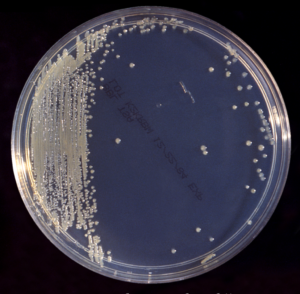Bacteria
Staphylococcus lugdunensis
Bacteria Staph lugdunensis is a coagulase-negative Staphylococcus (CoNS) capable of causing aggressive diseases like Staph aureus. Staph lugdunensis tends to be more susceptible to antibiotics compared to other CoNS. Vancomycin tolerance – can be present, i.e. the ability of bacteria to survive in the presence of an antibiotic, even if MIC testing has deemed that […]
Shiga toxin-producing E coli: E coli O157
Introduction There are various types of E coli that live in the environment and our intestines. Although most live inside our bowel harmlessly and even be beneficial, some E coli may cause infection, like UTI, bacteraemia, gastroenteritis etc. The E coli causing gastroenteritis could be divided into six phenotypes – Shiga toxin-producing E. coli (STEC) [or EHEC/VTEC] […]
Rothia mucilaginosa
The Bacteria Rothia belongs to the family Micrococcaceae – the same family as Micrococcus spp., Stomatococcus spp. and Kocuria spp. There are 8 species of Rothia – but only Rothia dentocariosa and Rothia mucilaginosa has been associated with human disease. It is a member of the mouth and upper respiratory tract flora. Laboratory Infection Rothia […]
Plesiomonas shigelloides
Plesiomonas shigelloides characteristics Plesiomonas shigelloides is a gram-negative bacillus that derived its name from the ancient Greek word plēsíon, which means “near” or “neighbour”, as it was considered near or related to the bacteria Aeromonas. It is mostly found in freshwater, estuarine, or brackish water environments. It can be found in animals living in these environments, […]
Leptospira spp.
This is from a presentation. The pictures were my slides. Feel free to download them if you wish. Leptospirosis, a zoonosis, is caused by a pathogenic Spirochaeta of the genus Leptospira.The name is derived from the Greek leptos (thin) and the Latin spira (coiled). Leptospirosis is a multisystem disease first described by Albert Weil in […]
Kingella spp.
Bacteria: Fastidious gram-negative coccobacilli that appear in pairs or short chains.Commensal of the mouth and upper respiratory tract.The genus Kingela have species like – K. kingae, K. denitrificans, Kingella negevensis, K. oralis etc. Identification: It appears as pairs/short chains of plump bacilli (or coccobacilli) with tapered ends.Capnophilic and facultatively anaerobic, nonmotile, non-spore-forming.Beta-haemolytic colonies on blood agar often produce marked pitting […]
Leclercia adecarboxylata
While authorising the urine result – I found that a urine sample from the community has grown Leclercia adecarboxylata. The patient is a young female complaining of increased frequency. The number of organisms in the urine was >100,000 organisms/ml.What is the significance? The bacteria Previously known as Escherichia adecarboxylata, it now belongs to a new genus Leclercia […]
Fusobacterium necrophorum
Bacteria Fusobacterium necrophorum is a Gram-negative, non-motile, non-spore-forming anaerobic pleomorphic bacterium. It may appear in coccobacillus or filamentous forms, which are more common in younger cultures. It is a member of the normal bacterial flora of the oropharynx, genitourinary tract, and gastrointestinal tract. Culture and identification There are 14 species of Fusobacterium, 10 of which […]
Eikenella corrodens
Bacteria: Pathogenicity: Culture and identification: Infection caused by Eikenella: Points to remember Eikenella corrodens is usually susceptible to: Non-susceptible to:
Cronobacter sakazakii: pathogen from infant formula feed
What is Cronobacter sakazakii? Cronobacter sakazakii is a gram-negative bacteria that can cause necrotising enterocolitis, septicaemia, and meningitis in infants, particularly low-birth-weight neonates. It has repeatedly been associated with reconstituted powdered infant formula. It can also cause infection in adults, especially in vulnerable groups like older people. Infection in infants is associated with a high […]



